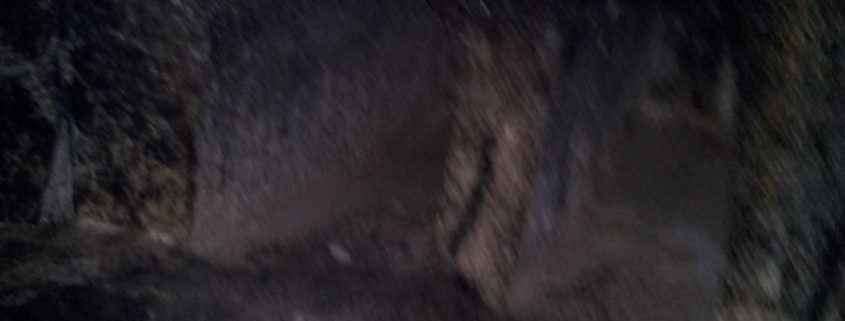One of the burning questions in the minds of humans since the beginning of the time has been, “Where do I go when I die?” The pagans and Jews of the ancient Near East had definite ideas on the subject, although they’re scattered through the Bible and across a multitude of texts recovered by archaeologists over the last two hundred years. By piecing together the evidence, we can assemble a rough idea of what they believed about the layout of the netherworld.
In ancient Mesopotamia, the underworld was a dismal place—damp, gloomy, and generally unpleasant. As we noted earlier, the quality of one’s afterlife depended on the faithfulness of his or her descendants and how well they performed the monthly kispum rite. Abraham’s distress at not having an heir was that he and Sarah would have to depend on a servant, Eliezer, to be the “son of the cup,” the “pourer of water,” to ensure their well-being in the netherworld. This tradition was so deeply ingrained in the cultures of the ancient world, from Babylon to Rome, that early Roman Christians built churches in cemeteries, including St. Peter’s Basilica, and installed libation tubes in sarcophagi.
But what about the physical layout of the underworld? Were there actual gates? How about the landscape—were there hills, cliffs, pits, and other physical features described in pagan myth?
While the Bible tells us more about the netherworld than we’ve probably been taught, it leaves a lot to the imagination. In the Old Testament, the term for the land of the dead is Sheol. There is no consensus on the origin of the Hebrew word. Unlike Greek myths of Hades, Sheol was not personified by the ancient Hebrews, although there are metaphorical references, such as the proverb that describes Sheol as “never satisfied” and Isaiah’s warning that “Sheol has enlarged its appetite and opened its mouth without measure,” which is strikingly similar to the voracious hunger of the Canaanite death-god, Mot.
One of the most famous pagan myths of the patriarchal era, The Descent of Inanna, tells the story of the aftermath of one of the episodes of the Epic of Gilgamesh. In that story, the heroic king of Uruk spurned the sexual advances of the Queen of Heaven, rudely (but truthfully) pointing out that the men in Inanna’s life usually came to an unhappy end. (Remember the story of Inanna’s husband, Dumuzi, who was dragged down to the netherworld so she could escape the Great Below. Inanna, better known to us as Ishtar (Astarte in the Bible), didn’t handle rejection well. The old saying, “Hell hath no fury like a woman scorned,” applies double when the woman has godlike power. Imagine a spoiled, supernatural fourteen-year-old, and you have an idea of the character of Inanna: Raging hormones, violent temper, and virtually no restrictions on her abilities.
In a rage, Inanna flew up to heaven and demanded that the sky-god, Anu, release the Bull of Heaven to destroy Gilgamesh and his city. The king and his friend Enkidu finally managed to kill the bull, but not before it killed hundreds of innocent civilians. Enkidu then added insult to the goddess’ injury by tearing off the bull’s right thigh and throwing it in Inanna’s face. (Interestingly, the right thigh of sacrificed bulls was given to the Temple priests, according to the Law of Moses.)
Here’s the thing: The Bull of Heaven was Gugalanna, consort of the Queen of the Great Below, Ereshkigal. This adds dramatic tension to the plot of The Descent of Inanna: The Queen of Heaven claimed that she’d arrived at the gates of the underworld for the funeral rites of Ereshkigal’s husband—whose death was Inanna’s fault. No wonder Ereshkigal “slapped her thigh and bit her lip.” What gall!
The relevant point is that the realm of the dead was depicted as a place below the earth behind seven gates that could not be passed without the permission of the sovereign of the underworld. This is similar to the Egyptian concept of the passage to the netherworld. As in The Descent of Inanna, two of the spells in the Egyptian Book of the Dead describe a series of seven doorways in “the house of Osiris in the west,” which was guarded by triads of demonic creatures—a “doorkeeper,” a “herald,” and a “watcher.” These entities were often referred to as ntr, an Egyptian term borrowed by Isaiah to describe the rebel in Eden—a word that meant “dead god,” often applied to Osiris, the Egyptian lord of the dead. Our English Bibles translate the word “branch” in Isaiah 14:19 on the assumption that the prophet had used the Hebrew word netser.
You obviously noticed that the Egyptians, like the Hebrews, were familiar with the concept of Watchers, although their role in Egyptian religion as door-guardians of the underworld was much more specific than that of their counterparts in Jewish and Mesopotamian cosmology (where they were called apkallu).
Like the Mesopotamian myths and the Egyptian Book of the Dead, the Bible describes Sheol as a place below the earth where the dead are prevented from returning by some type of physical barrier.
As the cloud fades and vanishes,
so he who goes down to Sheol does not come up. (Job 7:9)
Will it go down to the bars of Sheol?
Shall we descend together into the dust? (Job 17:16)
I said, In the middle of my days
I must depart;
I am consigned to the gates of Sheol
for the rest of my years. (Isaiah 38:10)
So, during the era of the patriarchs and prophets, Hebrews saw Sheol as a place occupied by the dead where “bars” and “gates” kept them from returning to the living (in physical form, anyway). However, even then there was hope that the righteous would someday be raised from that dreary plane of existence.
The Lord kills and brings to life;
he brings down to Sheol and raises up. (1 Samuel 2:6)
For I know that my Redeemer lives,
and at the last he will stand upon the earth.
And after my skin has been thus destroyed,
yet in my flesh I shall see God,
whom I shall see for myself,
and my eyes shall behold, and not another.
My heart faints within me! (Job 19:25–27)
There was a category of malevolent dead known to occupy the netherworld, who, like the loathed “dead god,” are mentioned in Isaiah 14:
Sheol beneath is stirred up
to meet you when you come;
it rouses the shades [Rephaim] to greet you,
all who were leaders of the earth;
it raises from their thrones
all who were kings of the nations. (Isaiah 14:9)
While Isaiah mocked the Rephaim spirits as “weak,” sleeping on beds of maggots with worms for covers, it’s clear from the text that these were once men of power. This is consistent with their depiction in the texts from Ugarit, where these “warriors of Baal” were summoned through necromancy rituals to the tabernacle of El (Mount Hermon).
The prophet Ezekiel, writing about 125 years or so after Isaiah, suggested that there is a hierarchy in the underworld and that the spirits of the “mighty men who were of old” occupy a place of primacy.
Ezekiel 32 is one of the more fascinating chapters in the Bible. It gives us the only glimpse into the physical layout of Sheol and the placement of the spirits in it.
They shall fall amid those who are slain by the sword. Egypt is delivered to the sword; drag her away, and all her multitudes. The mighty chiefs shall speak of them, with their helpers, out of the midst of Sheol: “They have come down, they lie still, the uncircumcised, slain by the sword.” (Ezekiel 32:20–21)
The Hebrew phrase rendered “mighty chiefs,” elei gibborim, could also be translated “chiefs” or “rulers of the Gibborim.” Their placement in the “midst of Sheol” suggests that they are fundamentally and substantially different from the run-of-the-mill dead, a callback to the long tradition among the Jews of the gibborim (“mighty men”) of old—the Nephilim.
The context of Ezekiel 32 is a lament over Pharaoh and his people, whose lands would be ravaged by the Chaldean army of Nebuchadnezzar, king of Babylon. The Egyptians are described as going “down to the pit” to lie among the dead from Assyria, “whose graves are set in the uttermost parts of the pit.” The location around the outer edges of Sheol suggests the Assyrians held a place of lower status, not surprising given that their army destroyed the northern kingdom of Israel. Likewise, Elam, Meshech-Tubal, Edom, the Sidonians, and “the princes of the north” will greet Pharaoh on his arrival in the netherworld.
Ezekiel’s choices of the “uncircumcised” nations in Sheol are worth study, considering that Meshech, Tubal, and the princes of the north figure prominently in his prophecy of Gog of Magog just a few chapters later. For now, however, what’s important is that several of these nations—Assyria, Elam, Meshech-Tubal, and the princes of the north—are described as having “spread terror in the land of the living.” The sense of the word translated “terror,” chittiyth, isn’t quite captured by the English. Chittiyth implies a supernatural fear, panic, like one would feel when suddenly confronted by, well, a ghost.
Or in this case, the ghosts of giants.
And they do not lie with the mighty, the fallen from among the uncircumcised, who went down to Sheol with their weapons of war, whose swords were laid under their heads, and whose iniquities are upon their bones; for the terror of the mighty men was in the land of the living. (Ezekiel 32:27)
Again, the English translation hides the meaning that was plain to the readers of Ezekiel’s book 2,500 years ago. Let’s consider an alternate translation:
But they do not lie down with the fallen Gibborim of ancient times, who went down to Sheol, with their weapons of war, their swords placed under their heads, and their iniquities upon their bones, for the terror of the Gibborim was in the land of the living.
Ezekiel was clearly saying the power of the nations he named was to cause terror “in the land of the living”—in other words, while they were alive. The prophet portrays the spirits of the dead as powerless to affect the living. Once they’re in Sheol, they don’t come back through the gates. This is contrary to the Amorite view of the Rephaim, the spirits of the gibborim of old, and, later, the Greek concept of heros, demigods who were, as the semi-divine children of gods and humans, Nephilim. Ezekiel essentially echoed Isaiah’s description of the Rephaim as weak and powerless, thus condemning the cult of the royal dead that persisted from before the time of Abraham down to the prophet’s day.
But the connection between the “mighty men” in the pit and the giants who walked the earth before the Flood is even more obvious than that. The bias of translators through the ages has obscured the prophet’s intent. The phrase, gibbôrîm nōpĕlîm mēʿôlām, literally “mighty fallen ones of old,” clearly alludes to the giants of Genesis 6:1-4, and may in fact be an explicit reference. Some scholars believe nōpĕlîm contains a mispointed vowel and should be read nĕpīlîm, which would transform the verse into:
But they do not lie down with the [mighty Nephilim] of ancient times, who went down to Sheol, with their weapons of war, their swords placed under their heads, and their iniquities upon their bones, for the terror of the [mighty ones] was in the land of the living.
The alternate translation doesn’t change the meaning of the verse or the chapter, it just makes the meaning plainer: There are entities in in the underworld who were separate and distinct from the human warriors who caused terror in the land of the living. These gibborim, spirits of the Nephilim of ancient times, held a central place in Sheol. Yet, echoing Isaiah, Ezekiel made it clear that these spirits no longer had the power to instill the kind of panicky terror they did when alive.
Neither did they have the power ascribed to them by the pagan Amorites or the later Greeks, who venerated such heros as Bellerophon, Perseus, and Herakles—who, you may be surprised to learn, was worshiped as Melqart, the chief god of Jezebel’s home city, Tyre. (Which means the prophets of Baal slaughtered on Mount Carmel were prophets of Hercules!)
Not coincidentally, scholar Nicolas Wyatt points out that Bellerophon, called “the greatest hero and slayer of monsters, alongside Cadmus and Perseus, before the days of Heracles,” is “a transparent transcription of West Semitic Baʿal Rapi’u” (“Lord of the Rephaim”). Bellerophon was believed to be the son of a mortal woman by the sea-god Poseidon. Like Satan, Bellerophon was punished for his arrogance, aspiring to claim a place on the holy mountain of the gods. Instead, he was cast down to earth to live out his days in misery on the Plain of Aleion (“Wandering”).
As demonic spirits, the gibborim of old still interacted with the living. The worship of these spirits continues to this day under the guise of ancestor veneration. But they’re on a short leash. Demons only enter where an entry has been prepared, either through trauma or by invitation. Otherwise, they remain in “the midst of Sheol,” kings among the dead.
A day is coming, however, when the gatekeeper will fling open the gates, and hell will literally break loose upon the earth.

Derek Gilbert Bio
Derek P. Gilbert hosts SkyWatchTV, a Christian television program that airs on several national networks, the long-running interview podcast A View from the Bunker, and co-hosts SciFriday, a weekly television program that analyzes science news with his wife, author Sharon K. Gilbert.
Before joining SkyWatchTV in 2015, his secular broadcasting career spanned more than 25 years with stops at radio stations in Philadelphia, Saint Louis, Little Rock, and suburban Chicago.
Derek is a Christian, a husband and a father. He’s been a regular speaker at Bible prophecy conferences in recent years. Derek’s most recent book is The Great Inception: Satan’s PSYOPs from Eden to Armageddon. He has also published the novels The God Conspiracy and Iron Dragons, and he’s a contributing author to the nonfiction anthologies God’s Ghostbusters, Blood on the Altar, I Predict: What 12 Global Experts Believe You Will See by 2025, and When Once We Were a Nation.





Leave a Reply
Want to join the discussion?Feel free to contribute!